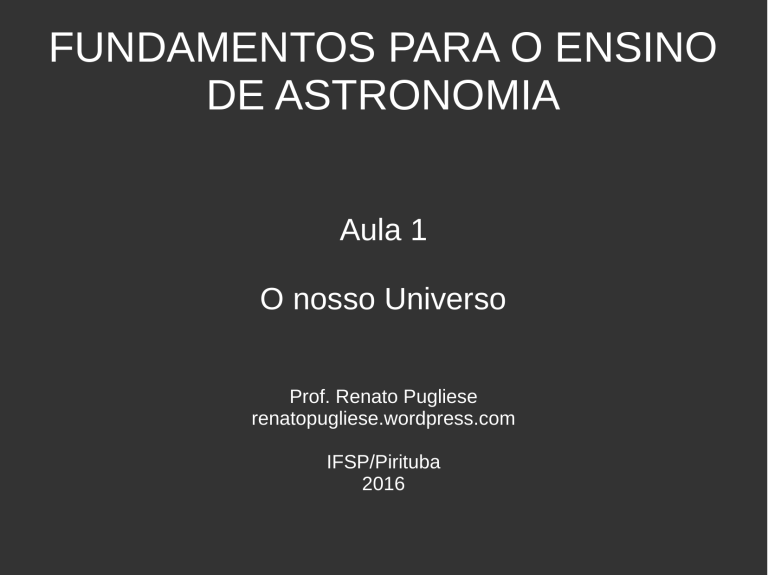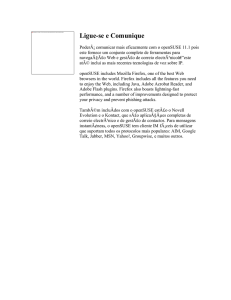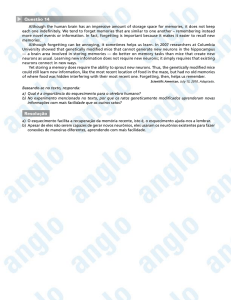
FUNDAMENTOS PARA O ENSINO
DE ASTRONOMIA
Aula 1
O nosso Universo
Prof. Renato Pugliese
renatopugliese.wordpress.com
IFSP/Pirituba
2016
I. Apresentação
●
Recepção e boas vindas;
●
Levantamento inicial;
●
Apresentação do curso:
I. Apresentação
Aula
Conteúdo
1
O nosso Universo (sistema solar, estrelas próximas, nossa galáxia, universo) – Cap. 1
2
Ferramentas do astrônomo (luz, telescópios, imagens, fotometria, espectroscopia) – Cap. 2
3
Astronomia Clássica (origens, mov. aparente, coordenadas, fases da Lua, estações) – Cap. 3
4
Astronomia Clássica (medidas de tempo, calendários, eclipses, zodíaco) – Cap. 3
5
Mecânica celeste (cinemática, mecânica newtoniana, mec. einsteiniana, caos) – Cap. 4
6
O Sol (dados, estrutura interna, atmosfera, atividade solar) – Cap. 5
7
O sistema solar (planetas, corpos menores, formação) – Cap. 6
8
Estrelas (Sol, outras estrelas, diagrama H-R, vida, nascimento, evolução e morte) – Cap. 7
9
Objetos estelares compactos (anãs, supernovas, pulsares, nêutrons, buracos negros) – Cap. 8
10
A galáxia (histórico, estrutura, constituintes, população, rotação, Via Láctea) – Cap. 9
11
Galáxias (morfologia, quasares, NAGs, energia) – Cap. 10 e 11
12
Distribuição das galáxias no Universo (grupo local, aglomerados, radiação de fundo) – Cap. 12
13
Cosmologia (evolução do Universo, expansão, modelos, origem, Big Bang) – Cap. 13
14
Atividade final: apresentação dos trabalhos (1, 2, 3 e 4)
15
Atividade final: apresentação dos trabalhos (5, 6, 7 e 8)
I. Apresentação
Bibliografia básica:
1. FRIAÇA, Amâncio C. S.; DAL PINO, Elisabete; SODRÉ JR., Laerte; JATENCO-PEREIRA, Vera
(orgs). Astronomia: uma visão geral do Universo. EDUSP, 2ª Ed., São Paulo, 2003.
2. NASA. Astronomy Picture of the Day (APOD). Página na internet: apod.nasa.gov
Materiais complementares:
Sky Map. Aplicativo gratuito para celulares/smartphones.
Stellarium. Software gratuito para computadores.
WinStars. Software gratuito para computadores.
Carta Celeste (Star Chart). Aplicativo gratuito para celulares/smartphones.
Avaliação:
Apresentação (resumo impresso com 2500 a 5000 caracteres e apresentação para a turma de até
15 minutos) de algum artigo científico estudado da área de Astronomia, Astrofísica, Cosmologia,
Ensino de Física, Ensino de Astronomia e afins, e sua relação com o nosso curso.
II. O sistema solar
Terra
(Equinócio
terrestre)
2013 September 28
Equinox Earth
Image Credit: Roscosmos / NTSOMZ / zelenyikot.livejournal.com Courtesy: Igor Tirsky, Vitaliy Egorov
Explanation: From a geostationary orbit 36,000 kilometers above the equator, Russian meteorological satellite Elektro-L takes high-resolution images of our fair planet every 30
minutes. But only twice a year, during an Equinox, can it capture an image like this one, showing an entire hemisphere bathed in sunlight. At an Equinox, the Earth's axis of
rotation is not tilted toward or away from the Sun, so the solar illumination can extend to both the planet's poles. Of course, this Elektro-L picture was recorded on September
22nd, at the northern hemisphere's autumnal equinox. For a moment on that date, the Sun was behind the geostationary satellite and a telltale glint of reflected sunlight is seen
crossing the equator, at the location on the planet with satellite and sun directly overhead (5MB animated gif).
II. O sistema solar
Terra
(Terra Cheia,
Lua Cheia)
2015 August 7
Full Moon, Full Earth
Image Credit: NASA, NOAA/DSCOVR
Explanation: The Moon was new on July 16. Its familiar nearside facing the surface of planet Earth was in shadow. But on that date a million miles away, the Deep Space
Climate Observatory (DSCOVR) spacecraft's Earth Polychromatic Imaging Camera (EPIC) captured this view of an apparently Full Moon crossing in front of a Full Earth. In fact,
seen from the spacecraft's position beyond the Moon's orbit and between Earth and Sun, the fully illuminated lunar hemisphere is the less familiar farside. Only known since the
dawn of the space age, the farside is mostly devoid of dark lunar maria that sprawl across the Moon's perpetual Earth-facing hemisphere. Only the small dark spot of the
farside's Mare Moscoviense (Sea of Moscow) is clear, at the upper left. Planet Earth's north pole is near 11 o'clock, with the North America visited by Hurricane Dolores near
center. Slight color shifts are visible around the lunar edge, an artifact of the Moon's motion through the field caused by combining the camera's separate exposures taken in
quick succession through different color filters. While monitoring the Earth and solar wind for space weather forcasts, about twice a year DSCOVR can capture similar images of
Moon and Earth together as it crosses the orbital plane of the Moon.
II. O sistema solar
Sol
(Atravessando
o Sol)
2015 April 30
Across the Sun
Image Credit & Copyright: Göran Strand
Explanation: A long solar filament stretches across the relatively calm surface of the Sun in this telescopic snap shot from April 27. The negative or inverted narrowband image
was made in the light of ionized hydrogen atoms. Seen at the upper left, the magnificent curtain of magnetized plasma towers above surface and actually reaches beyond the
Sun's edge. How long is the solar filament? About as long as the distance from Earth to Moon, illustrated by the scale insert at the left. Tracking toward the right across
the solar disk a day later the long filament erupted, lifting away from the Sun's surface. Monitored by Sun staring satellites, a coronal mass ejection was also blasted from the site
but is expected to swing wide of our fair planet.
II. O sistema solar
Sol (Um
filamento
extremamente
comprido
sobre o Sol)
2015 February 10
An Extremely Long Filament on the Sun
Image Credit & Copyright: Oliver Hardy
Explanation: Yesterday, the Sun exhibited one of the longest filaments ever recorded. It may still be there today. Visible as the dark streak just below the center in the featured
image, the enormous filament extended across the face of the Sun a distance even longer than the Sun's radius -- over 700,000 kilometers. A filament is actually
hot gas held aloft by the Sun's magnetic field, so that viewed from the side it would appear as a raised prominence. The featured image shows the filament in
light emitted by hydrogen and therefore highlights the Sun's chromosphere. Sun-following telescopes including NASA's Solar Dynamics Observatory (SDO) are tracking
this unusual feature, with SDO yesterday recording a spiraling magnetic field engulfing it. Since filaments typically last only from hours to days, parts of this one may collapse or
erupt at any time, either returning hot plasma back to the Sun or expelling it into the Solar System. Is the filament still there? You can check by clicking on
SDO's current solar image.
II. O sistema solar
Lua (Uma
Lua azul
sangue)
2015 October 03
A Blue Blood Moon
Image Credit & Copyright: Dominique Dierick
Explanation: This sharp telescopic snapshot caught late September's Harvest Moon completely immersed in Earth's dark umbral shadow, at the beginning of a total lunar eclipse.
It was the final eclipse in a tetrad, a string of four consecutive total lunar eclipses. A dark apparition of the Full Moon near perigee, this total eclipse's color was a deep blood red,
the lunar surface reflecting light within Earth's shadow filtered through the lower atmosphere. Seen from a lunar perspective, the reddened light comes from all the sunsets and
sunrises around the edges of a silhouetted Earth. But close to the shadow's edge, the limb of the eclipsed Moon shows a distinct blue hue. The blue eclipsed moonlight is still
filtered through Earth's atmosphere though, originating as rays of sunlight pass through layers high in the upper stratosphere, colored by ozone that scatters red light and
transmits blue.
II. O sistema solar
Lua
(Procurando
o Homem na
Lua)
2016 February 1
Find the Man in the Moon
Image Credit & Copyright: Dani Caxete
Explanation: Have you ever seen the Man in the Moon? This common question plays on the ability of humans to see pareidolia -- imagining familiar icons where they don't actually
exist. The textured surface of Earth's full Moon is home to numerous identifications of iconic objects, not only in modern western culture but in world folklore throughout history.
Examples, typically dependent on the Moon's perceived orientation, include the Woman in the Moon and the Rabbit in the Moon. One facial outline commonly identified as the
Man in the Moon starts by imagining the two dark circular areas -- lunar maria -- here just above the Moon's center, to be the eyes. Surprisingly, there actually is a man in this Moon
image -- a close look will reveal a real person -- with a telescope -- silhouetted against the Moon. This featured well-planned image was taken in mid-January in
Cadalso de los Vidrios in Madrid, Spain. Do you have a favorite object that you see in the Moon?
II. O sistema solar
Terra, Sol e Lua
DT-L = 384.000 km = 1 segundo-luz
c = 300.000 km/s
DT-S = 146.000.000 km = 8 min-luz = 1 U.A.
Outros...
Júpiter
ΦJ = 11.ΦT
DJ-S = 5 U.A.
Saturno
ΦSat = 9.ΦT
DSat-S = 10 U.A.
Plutão
DPlu-S = 40 U.A. = 5,5 h-luz
“Borda” do Sistema Solar, região de formação de cometas
Dborda-S = 100.000 U.A. = 1,5 ano-luz
II. O sistema solar
Júpiter
(Conjunção
com três luas)
2015 February 6
Jupiter Triple-Moon Conjunction
Image Credit: NASA, ESA, and the Hubble Heritage Team (STScI/AURA)
Explanation: Our solar system's ruling giant planet Jupiter and 3 of its 4 large Galilean moons are captured in this single Hubble snapshot from January 24. Crossing in front of
Jupiter's banded cloud tops Europa, Callisto, and Io are framed from lower left to upper right in a rare triple-moon conjunction. Distinguishable by colors alone icy Europa is almost
white, Callisto's ancient cratered surface looks dark brown, and volcanic Io appears yellowish. The transiting moons and moon shadows can be identified by sliding your cursor over
the image, or following this link. Remarkably, two small, inner Jovian moons, Amalthea and Thebe, along with their shadows, can also be found in the sharp Hubble view. The
Galilean moons have diameters of 3,000 to 5,000 kilometers or so, comparable in size to Earth's moon. But odd-shaped Amalthea and Thebe are only about 260 and 100 kilometers
across respectively.
II. O sistema solar
Saturno
(As estações
de Saturno)
2003 April 5
The Seasons of Saturn
Credit: R. G. French (Wellesley College) et al., Hubble Heritage Team (AURA / STScI / NASA)
Explanation: Since Saturn's axis is tilted as it orbits the Sun, Saturn has seasons, like those of planet Earth ... but Saturn's seasons last for over seven years. So what season is it
on Saturn now? Orbiting the equator, the tilt of the rings of Saturn provides quite a graphic seasonal display. In fact, this month, Saturn's rings will reach their most "open" angle
after appearing nearly edge on in the mid-1990s. The ringed planet is also well placed in evening skies providing a grand view as summer comes to Saturn's southern
hemisphere and winter to the north. The Hubble Space Telescope took the above sequence of images about a year apart, starting on the left in 1996 and ending on the right in
2000. Although they look solid, Saturn's Rings are likely less than 50 meters thick and consist of individually orbiting bits of ice and rock ranging in size from grains of sand to
barn-sized boulders.
II. O sistema solar
Cometas
(Apresentando
o Cometa
Catalina)
2015 August 18
Announcing Comet Catalina
Image Credit & Copyright: Ian Sharp
Explanation: Will Comet Catalina become visible to the unaided eye? Given the unpredictability of comets, no one can say for sure, but it seems like a good bet. The comet was
discovered in 2013 by observations of the Catalina Sky Survey. Since then, Comet C/2013 US10 (Catalina) has steadily brightened and is currently brighter than 8th magnitude,
making it visible with binoculars and long-duration camera images. As the comet further approaches the inner Solar System it will surely continue to intensify, possibly becoming a
naked eye object sometime in October and peaking sometime in late November. The comet will reside primarily in the skies of the southern hemisphere until mid-December, at
which time its highly inclined orbit will bring it quickly into northern skies. Featured above, Comet Catalina was imaged last week sporting a green coma and two growing tails.
III. As estrelas mais próximas
Uma Noite Estrelada no Brasil
2009 May 9
A Starry Night in Brazil
Credit & Copyright: Babak Tafreshi (TWAN)
Explanation: This panoramic image tracing constellations in the southern sky shows off a beautiful vista toward the center of our Milky Way Galaxy. It was recorded just last
month near the city of Campos in northeastern Rio de Janeiro state, Brazil. A sugar cane field from one of the historic region's local farms lies in the foreground. From left to right,
the view sweeps across the Galactic Center in Sagittarius, bright stars in the tail of Scorpius, the South Celestial Pole above and right of the gap in the sugar canes, the dark
Coalsack Nebula, and the Southern Cross. The closest star system, Alpha Centauri, and the giant Omega Centauri globular star cluster also shine in the starry night.
III. As estrelas mais próximas
Alfa de Centauro (α-Centauri)
Dα-Cen-S = 4 anos-luz = 20.000.DSat-S = 200.000 U.A.
Sistema estelar triplo: α-Cen A e B (estrelas binárias) e Próxima Centauri
Nomenclatura clássica: Alfa, Beta, Gama, Delta... para cada constelação
Como medir a distância até a estrela?
Intensidade luminosa
Considerando α-Cen semelhante ao Sol, e sabendo que a intensidade luminosa diminui ao
quadrado da distância, temos que:
Brilho aparente: IS = 40x10⁹.Iα-Cen
Então: dα-Cen² = 200.000² = 40x10⁹
dα-Cen = 200.000.DT-S = 3 anos-luz (dados mais precisos – adiante - indicam 4,3 anos-luz)
Estrelas mais fracas visíveis a olho nu → 20 vezes mais distantes do que α-Cen (luz 400 vezes
mais fraca).
III. As estrelas mais próximas
Paralaxe
Exemplo com braço-dedo-olho
Proporção inversa Ângulo-Distância
Este método funciona para estrelas a até 300 anos-luz
do Sol, devido às restrições angulares.
Sirius ou Alfa de Cão Maior (α Canis Majoris)
Estrela mais brilhante no céu
DT-sirius = 8,6 anos-luz = 550.000.DT-S
Se ela tivesse a mesma luminosidade do Sol, deveria
ser vista 300.10⁹ vezes menos brilhante que o Sol.
Mas como é vista “apenas” 10.10⁹ vezes mais fraca,
então deve ser 30 vezes mais luminosa do que o Sol.
Conhecemos atualmente estrelas até 100.000 vezes mais
brilhantes que o Sol, como estrelas 100.000 vezes menos
brilhantes.
III. As estrelas mais próximas
Pôr da
Lua
sobre
simpática
baía.
2010 March 29
Moonset Over Pleasant Bay
Credit & Copyright: A. Dunlap-Smith; Drawing Acknowledgement: J. Hevelius
Explanation: It was a sky for the imagination. In the early evening last week, the sky illuminating the unaided eye was perhaps even more illuminating to the mind's eye. The
unaided eye saw clouds framing the Moon setting over a calm and reflective bay, spruce trees lining the nearby shores, the Pleiades open star cluster (M45) glowing prominently
in the center of the sky, the Andromeda galaxy hovering just over the horizon on the right, and the belt stars of Orion lined up on the left, just below the bright orange star
Betelgeuse. The bright star Sirius peeked out of the trees on the far left. The mind's eye might further imagine, however, some of the constellations coming to life, with
Orion the Hunter taking up his sword and shield, followed into battle by his Big Dog (Canis Major, whose right eye is Sirius), and watched from across the sky by Cassiopeia, the
Queen of Ethiopia, sitting on her Throne. The above image was taken over Pleasant Bay, Maine, USA, and digitally merged with constellations from Uranographicarum, drawn in
the 17th century by J. Hevelius.
IV. A nossa Galáxia
Via-Láctea sobre Agulhas
na Austrália
2016 February 17
Milky Way over the Pinnacles in Australia
Image Credit: Michael Goh
Explanation: What strange world is this? Earth. In the foreground of the featured image are the Pinnacles, unusual rock spires in Nambung National Park in Western Australia.
Made of ancient sea shells (limestone), how these human-sized picturesque spires formed remains unknown. In the background, just past the end of the central Pinnacle, is a
bright crescent Moon. The eerie glow around the Moon is mostly zodiacal light, sunlight reflected by dust grains orbiting between the planets in the Solar System. Arching across
the top is the central band of our Milky Way Galaxy. Many famous stars and nebula are also visible in the background night sky. The featured 29-panel panorama was taken and
composed last September after detailed planning that involved the Moon, the rock spires, and their corresponding shadows. Even so, the strong zodiacal light was a pleasant
surprise.
IV. A nossa Galáxia
O Sol e as estrelas próximas (α-Cen, por exemplo), encontram-se a 30.000 anos-luz do centro
desse sistema estelar que forma nossa Galáxia, usualmente chamada de Via-Láctea, e que
contém cerca de 100 bilhões de estrelas.
Forma de disco.
VS-centro.galáxia = 250 km/s (1 volta a cada 250 milhões de anos)
Δt(Sistema Solar) = 5 bilhões de anos-luz
Φgaláxia = 100.000 anos-luz
Centro da Via-Láctea (visto da Terra)
→ Entre Escorpião e Sagitário
IV. A nossa Galáxia
Nebulosa de Órion (próxima das
Três Marias):
Φnebulosa = 15 anos-luz;
dS-nebulosa = 1200 anos-luz.
Estrelas jovens, mais quentes,
luminosas e maiores do que o Sol
Rigel (α-Ori): cor branca-azulada
(13000 ºC); Supergigante Azul; dTRigel = 800 anos-luz.
Estrelas muito maiores do que o
Sol acabam em uma Supernova.
Betelgeuse (β-Ori): cor
avermelhada (3000 ºC); Gigante
vermelha (mil vezes maior que o
Sol).
2015 March 26
Orion Spring
Image Credit & Copyright: Bill Dickinson
Explanation: As spring comes to planet Earth's northern hemisphere, familiar winter constellation Orion sets in early evening skies and budding trees frame the Hunter's stars.
The yellowish hue of cool red supergiant Alpha Orionis, the great star Betelgeuse, mingles with the branches at the top of this colorful skyscape. Orion's alpha star is joined on
the far right by Alpha Tauri. Also known as Aldebaran and also a giant star cooler than the Sun, it shines with a yellow light at the head of Taurus, the Bull. Contrasting blue
supergiant Rigel, Beta Orionis, is Orion's other dominant star though, and marks the Hunter's foot below center. Of course, the sword of Orion hangs from the Hunter's three blue
belt stars near picture center, but the middle star in the sword is not a star at all. A slightly fuzzy pinkish glow hints at its true nature, a nearby stellar nursery visible to the
unaided eye known as the Orion Nebula.
IV. A nossa Galáxia
No
coração
de Órion
2015 January 2
At the Heart of Orion
Image Credit & Copyright: László Francsics
Explanation: Near the center of this sharp cosmic portrait, at the heart of the Orion Nebula, are four hot, massive stars known as the Trapezium. Tightly gathered within a region
about 1.5 light-years in radius, they dominate the core of the dense Orion Nebula Star Cluster. Ultraviolet ionizing radiation from the Trapezium stars, mostly from the brightest
star Theta-1 Orionis C powers the complex star forming region's entire visible glow. About three million years old, the Orion Nebula Cluster was even more compact in its
younger years and a dynamical study indicates that runaway stellar collisions at an earlier age may have formed a black hole with more than 100 times the mass of the Sun. The
presence of a black hole within the cluster could explain the observed high velocities of the Trapezium stars. The Orion Nebula's distance of some 1,500 light-years would make
it the closest known black hole to planet Earth.
IV. A nossa Galáxia
Sirius B: Anã-branca →
10000 km de diâmetro
(equiv. à Terra) ; massa
equiv. ao Sol (!);
Entrela de nêutrons
(~1967) ou Buracos Negros
→ Altíssima densidade.
2000 October 6
X-Rays From Sirius B
Credit: NASA/ CXC/ SAO
Explanation: In visible light Sirius A (Alpha Canis Majoris) is the brightest star in the night sky, a closely watched celestial beacon throughout recorded history. Part of a
binary star system only 8 light-years away, it was known in modern times to have a small companion star, Sirius B. Sirius B is much dimmer and appears so close to the brilliant
Sirius A that it was not actually sighted until 1862, during Alvan Clark's testing of a large, well made optical refracting telescope. For orbiting x-ray telescopes, the Sirius situation
is exactly reversed, though. A smaller but hotter Sirius B appears as the overwhelmingly intense x-ray source in this Chandra Observatory x-ray image (lines radiating from Sirius
B are image artifacts). The fainter source seen at the position of Sirius A may be largely due to ultraviolet light from the star leaking into the x-ray detector. With a surface
temperature of 25,000 kelvins, the mass of the Sun, and a radius just less than Earth's, Sirius B is the closest known white dwarf star. Can you guess what makes Sirius B like
Neptune, the Sun's most distant gas giant planet? While still unseen, the presence of both celestial bodies was detected based on their gravitational influence alone ... making
them early examples of dark matter.
V. A Galáxia e suas vizinhas:
o Grupo Local
Afastando-nos 50 vezes o
tamanho da nossa Galáxia temos
o Grupo Local, contendo pouco
mais de 30 galáxias, incluindo as
Nuvens de Magalhães (200.000
anos-luz) e a galáxia de
Andrômeda (2 milhões de anosluz).
Galáxias podem ser espirais,
elípticas, entre outras. Em seu
núcleo, em caso de atividade
recente, podem ter quasares e
buracos negros.
2015 August 30
M31: The Andromeda Galaxy
Image Credit & Copyright: Robert Gendler
Explanation: What is the nearest major galaxy to our own Milky Way Galaxy? Andromeda. In fact, our Galaxy is thought to look much like Andromeda. Together these two
galaxies dominate the Local Group of galaxies. The diffuse light from Andromeda is caused by the hundreds of billions of stars that compose it. The several distinct stars that
surround Andromeda's image are actually stars in our Galaxy that are well in front of the background object. Andromeda is frequently referred to as M31 since it is the 31st object
on Messier's list of diffuse sky objects. M31 is so distant it takes about two million years for light to reach us from there. Although visible without aid, the above image of M31 is a
digital mosaic of 20 frames taken with a small telescope. Much about M31 remains unknown, including exactly how long it will before it collides with our home galaxy.
VI. Aglomerados de galáxias e o
Universo
Aglomerados de galáxias são comuns no
Universo.
Não há uniformidade na distribuição de
aglomerados. São espaços vazios e
aglomerados aleatórios.
Há mais matéria (e energia) no Universo do
que podemos identificar hoje. Cerca de 90%
da energia no Universo é desconhecida, a
qual chamamos Energia (ou Matéria)
Escura.
Também é sabido que os aglomerados
estão se afastando uns dos outros e, quanto
mais distantes estão, mais velozmente se
afastam, o que nos levou ao conceito do Big
Bang, explosão ocorrida há uns 15 bilhões
de anos.
2015 August 9
HCG 87: A Small Group of Galaxies
Image Credit: GMOS-S Commissioning Team, Gemini Observatory
Explanation: Sometimes galaxies form groups. For example, our own Milky Way Galaxy is part of the Local Group of Galaxies. Small, compact groups, like
Hickson Compact Group 87 (HCG 87) shown above, are interesting partly because they slowly self-destruct. Indeed, the galaxies of HCG 87 are gravitationally stretching each
other during their 100-million year orbits around a common center. The pulling creates colliding gas that causes bright bursts of star formation and feeds matter into their
active galaxy centers. HCG 87 is composed of a large edge-on spiral galaxy visible near the image center, an elliptical galaxy visible to its right, and a spiral galaxy visible near
the top. The small spiral near the center might be far in the distance. Several stars from our Galaxy are also visible in the foreground. Studying groups like HCG 87 allows
insight into how all galaxies form and evolve.
VII. Retrospectiva
Terra, Lua, Sol...
Júpiter, Saturno...
Estrelas mais próximas...
Nossa Galáxia...
Aglomerados...
Quasares...
Limites do Universo conhecido.
E o futuro?
VIII. Atividade
Durante a aula:
- Desenhar ou representar o Sistema Terra-Sol e Terra-Lua em escala de tamanho e de distância.
Dados:
Diâmetros: D(Terra) = 12,8.10⁶ m; D(Sol) = 1,4.10⁹ m; D(Lua) = 3,5.10 ⁶ m
Distância da Terra: d(Sol) = 1,5.10¹¹ m; d(Lua) = 3,84.10 ⁸ m.
Após a aula:
- Observar no céu:
18 e 19/08 às 22:00h
Lua a 50º entre o Leste e o Zênite (em Aquário); Cruzeiro do Sul se ponto entre Oeste e Sul; Rigel
(alfa Cen) acima do Cruzeiro do Sul; Saturno e Marte a 40º entre Oeste e Zênite.
19/08 às 18:15h
Vênus, Mercúrio e Júpiter se pondo no Oeste; Lua nascendo no Leste; Saturno e Marte no Zênite.
- Ler capítulos 1 e 2 do texto base (disponível no blog);
- Conhecer o site APOD e verificar como funciona o sistema de busca.












